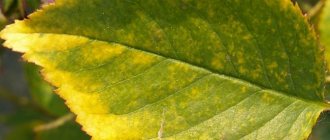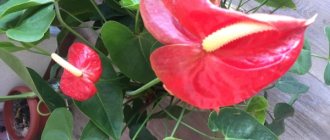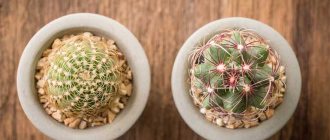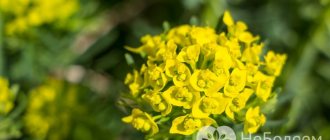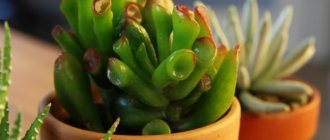One of the most popular species grown at home can be safely called Opuntia. This is a very large family, numbering over 300! Various types. Of course, you can’t tell about all of them, but the most common ones at home are worth mentioning.
The cactus is very attractive with its unusual shape of stems that look like “ears”. And although America is considered the birthplace of the plant, Opuntia feels quite well in almost any corner of the world. In addition, if winters in your region are not too severe, and the thermometer does not fall below 10 degrees below zero, then the cactus can even be planted in open ground in the garden or, for example, in a flower bed.
In addition, in this article you will learn how to properly care for Prickly Pear, what beneficial properties it has, why the cactus is sick and how to propagate it, and most importantly, which species are most popular for growing. Let's get started!
Description of cacti of the genus Opuntia
The succulent plant Opuntia is a large genus of 180 species of cacti in the family Cactaceae (Cactaceae) native to the Americas. Prickly pear is found from the Peace River in western Canada almost to the tip of South America. In the Northern Hemisphere, the Opuntia fragilis variety is one of the northernmost cacti species. In the West it is also called Paddle or Nopal cactus.
Most Opuntia species are erect or spreading cacti, ranging from small, low-growing shrubs to tree-like specimens reaching 5 meters in height. Prickly pear grows in arid and semi-arid areas and can be found on sandy coastal beaches, sandy prairies, and rocky hillsides. Although they love sun and thrive in hot climates, Prickly Pear is one of the more cold-hardy species of lowland cacti. Some varieties of prickly pear can withstand temperatures as low as -10 °C.
Opuntia are easily recognized by their flat, spade-shaped stem segments, called cladodes, growing one at the end of the other. The stem plates take root easily. The edges and flat surfaces of these cladodes are covered with areoles, which always have tiny, easily detachable spines called glochids.
Photo of glochids and spines of Opuntia
Many species of Opuntia have large needles in addition to glochids, but some are armed only with small needles. They appear soft, but anyone who touches them immediately regrets it. The small size of the glochids does not cause severe pain, but it does cause severe irritation.
Prickly Pear flowers open from spring to mid-summer, usually yellow, sometimes pink and rarely white or somewhere in between. The flowers are cup-shaped and do not have floral tubes, but the pericarps resemble rounded extensions of cladodes. It is not immediately possible to determine whether the new pagon will be a flower or a new cladode, as they are identical when first emerging—often covered with cone-shaped, deciduous leaves. Some prickly pears have very juicy, fleshy fruits that are harvested and made into candy or jellies. Likewise, the stem blades, when still young and tender, are harvested and eaten as vegetables - especially in Mexico under the name Nopales.
Several species of Opuntia, including the widely cultivated Opuntia ficus-indica from Mexico, are grown for their edible fruits and stems.
Many people despise Prickly Pear, even those who like to grow cacti. However, recently there seems to be renewed interest in this genus.
How to plant and grow Opuntia cactus
Growing this type of cactus can be started by sowing seeds or rooting the stem plate (cladodes). We will describe the propagation of Cladodes below and first we will talk about growing Opuntia from seeds.
How to Plant Prickly Pear Seeds
If you purchased Opuntia seeds, you need to prepare them before planting them in a pot. It is best to plant them in late winter or early spring. Start by soaking the hard seeds overnight (at least eight hours) before planting. For planting, use cactus potting mix or any light, well-drained soil. Place the seeds on the surface of the soil and press them down gently. Don't cover them up.
After planting the seeds, keep the soil evenly moist and warm until the shoots emerge. If your area is fairly dry, place a sheet of plastic or glass over the container to retain moisture. Keep the container with the seeds in a warm, well-lit place and don't be upset if they don't germinate right away. Prickly pear cactus seeds are notoriously slow to germinate, and you may have to wait up to a year.
How to grow Opuntia cactus from cuttings
Because cactus seeds take so long to germinate, rooting stem cuttings is the preferred form of propagation. Take cuttings at any time, but best in late spring or early summer (the height of the growing season).
It is very easy to cut off a segment of the stem blade, let it dry for a few days and plant the dried cutting in a pot of cactus mix or a potting mix of equal parts regular soil and sand or rough pumice. When planting cladodes, place it vertically at a depth of approximately 2.5 cm in the ground. Planting the cushion too deep will cause rot. To prevent the cutting from falling, it needs to be supported, for example, with toothpicks.
As with seeds, keep the soil slightly moist until you see signs of growth. Keep cuttings away from direct sunlight. Keep the container with the cutting in a warm, well-lit place with plenty of indirect sunlight until it takes root.
In a month, roots will form and the cutting will remain firmly in the soil.
The soil
Plant spiny cactus in a commercial cactus mix, or make your own using regular soil, sand and clay.
Light
Young Opuntia plants (under two years old) tolerate lots of bright, indirect sunlight. After ripening, it requires more open sun. In winter, keep Prickly Pear in a cool place with plenty of bright, indirect light.
Temperature
These cacti are very hardy and forgive mistakes in care. Mature plants can tolerate very high temperatures during the day and large temperature changes at night, down to -10 C.
They prefer hot, dry climates in the summer and cooler autumn and winter months. Protect your prickly pear cactus from freezing.
How to water a prickly pear cactus
Keep seedlings, cuttings and immature plants in slightly moist soil until they begin to grow. Once they have developed a couple of "leaves", you can let the soil dry out between waterings and then water thoroughly. Mature plants are very drought tolerant and require little water. Let the soil dry completely. Wait until the cactus becomes a little shriveled, then water it slowly and deeply. In winter, reduce watering by half as the plant will be dormant.
Fertilizer
Feed young plants with a water-soluble cactus fertilizer every couple of weeks. Mature plants should only be fed two to three times during the summer months. If you are growing Prickly Pear cactus for flowers and fruit, use a low-nitrogen fertilizer.
Replanting Opuntia
It is always recommended to repot plants that have outgrown the container as this will encourage new growth. If the roots get too large or the plant doesn't have enough stability in its current container, it's time to move it to a larger, more durable one.
The first thing you need to do before replanting your Prickly Pear is to make sure the soil is completely dry. Gently lift the cactus out of the pot, holding it by the base and removing any old soil.
If the cactus has damaged areas, treat them with a fungicide, then place it in a new pot and add well-drained cactus potting mix. Transplanted cacti do not need to be watered immediately. It's best to let it get used to its new environment before watering it.
Attention! When propagating, pruning or replanting Prickly Pear, you should always use thick gardening gloves and long sleeves.
If the cactus is quite large or difficult to handle, you may need a second pair of hands to hold it steady and prevent it from breaking during handling. Transplanted cacti may need external support, especially if they are tall and unstable.
Trimming
There is no need to trim prickly pear. Only in spring or late summer, remove plates that are touching each other or are damaged or poorly formed.
Sometimes you will have to wipe or rinse the cactus from time to time. Use a feather duster to wipe away dust and spray it with a hose during summer outdoors.
Reproduction
If you suddenly want to propagate Opuntia, you can do this in two ways:
- Seeds;
- By cuttings.
Seeds
This method is not very popular, because it is quite problematic. Not all seeds germinate, and it even happens that none at all. We have previously written about how to grow cacti from seeds, so the principle here is exactly the same, but there is one difference. Opuntia seeds have a rather dense shell, so they should first be rubbed with a file or sandpaper, and then soaked in potassium permanganate.
And then everything is as usual. Soil is poured into the greenhouse, holes are made there and seeds are planted. After this, you need to wait for shoots. The first transplant is performed after 3 months. More details are written in our separate article.
Cuttings
The most preferred method, which is much more effective than the previous one. There is nothing complicated about cuttings. First of all, take a well-sharpened knife and select any healthy shoot on the stem. Then, it should be cut off and then placed in an upright position in a place where it can dry a little. Usually it takes 3-4 days until a film appears at the cut site.
Also read: Zygocactus - Decembrist: homemade varieties with photos and care for them
Next, the dried cuttings should be planted in a container with wet sand, to a depth of 5-6 cm. The container itself must be covered with cling film and allowed to be ventilated periodically, as well as occasionally watered. As soon as the seedling has roots, it should be transplanted. How to do this can be read above.
Problems in care
The main problems with a cactus are almost always related to water. If your plant becomes shriveled or soft, it needs water. Water thoroughly and then drain off excess water. If you don't do this and your plant sits in water for a significant period of time, it may begin to droop or develop dark pulp at the base. This means it begins to rot. If this happens, you may not be able to save the original plant, but you may be able to grow a new plant by taking a cutting from an unaffected area.
Plant pests
To prevent the cactus from getting sick and growing vigorously, make sure that there are no mealybugs, spider mites or scale insects. If, after all, insects have captured the plant, you need to wash them off under running water; to be on the safe side, you can lightly walk over the cactus with a soft brush soaked in medical alcohol. If the problem with pests is advanced, then insecticidal soap can help. It is important to remember that any products that you spray on the cactus are best applied in the morning. Choose a place that is well ventilated, but where there is no direct sunlight, otherwise the plant may get burned.
Common varieties of cacti of the genus Opuntia
There are about 180 varieties of prickly pear cactus in different shapes and sizes. Some are low growing and ideal as houseplants, while others can reach over 5m in height. When choosing the perfect Prickly Pear, think about where you want to plant it and what size you can accommodate.
Remember! If you have children or pets and want to own this wonderful plant, please note that the stem segments of most Opuntias are covered with tiny needles called glochids. Once pricked by these glochids, they will most likely remain on the skin. They may cause skin irritation.
Let us describe several examples of beautiful cactus variations.
Indian or fig prickly pear (Opuntia ficus-indica)
Formerly called Opuntia vulgaris, it is grown far beyond its native home in Mexico for its edible fruit and stem. Reaches a height of 1.8-6 meters.
Indian prickly pear
The yellow flowers are followed by orange to red oval fruits called tuna in Spanish. Young cactus stems can also be boiled and eaten. Cacti of this variety are grown as an agricultural crop.
Opuntia compressa
The cactus is native to the northeast of North America. Naturalized in Southern Europe. Flowering from July to August.
Opuntia compressed cactus
This species is hermaphrodite (having both male and female organs) and is pollinated by insects. It requires little care, is easy to grow and produces beautiful pink flowers in summer.
Prickly pear (Opuntia humifisa)
This North American variety is popular among cactus growers because it bears golden-yellow flowers in summer and its red fruits are edible.
Prickly pear prostrate
Grows up to 30 cm in height and 45 cm in width. This species is characterized by the fact that the stem leaves of adult cacti do not grow upward, but lie on the ground, which is why it got its name.
Opuntia ellisiana
This variety of cactus does not have large needles, so it is usually considered a spineless cactus with yellow flowers.
Opuntia elysiana
Well, it does have small glaucids on the pads that can cause pain in the hand. It grows up to one meter in height and its leaf blades are edible.
Opuntia microdasys or small-haired prickly pear (Opuntia microdasys)
This species of Prickly Pear is native to the American Southwest and has rabbit-shaped nopals.
Prickly pear cactus
It is a bushy perennial cactus with flattened, segmented, oval or round stems that are light to medium green in color. In summer, yellow cup-shaped flowers up to 4-5 cm in diameter bloom.
Berger's prickly pear (Opuntia bergeriana)
A shrubby species, it grows up to 4.5 m with leaf-shaped stems up to 40 cm long. This plant blooms bright red flowers in large quantities.
Berger's prickly pear
The cactus is quite frost-resistant, tolerates temperatures from up to -10 °C.
Opuntia subulata
It grows naturally only in the Andes mountains in Peru. A well-known shrubby cactus with few main branches from the base, or a small tree with a simple erect trunk and a large, almost hemispherical apex, often 3 to 4 meters in height.
Photo of Opuntia subulata
The leaves are relatively large. Red flowers bloom towards the ends of the branches, not opening widely until 6 cm long.
Brittle or brittle prickly pear (Opuntia fragilis)
So named because of the weak connection of the stem leaves - they are easily separated from passing animals, which helps in reproduction, given that flowering occurs infrequently.
Prickly pear is brittle or brittle
The plant has an unremarkable appearance. The stem segments are rarely longer than 5 m and are noticeably thicker than those of other species, often cylindrical or potato-shaped.
Without needles
The vast majority of succulents are protected by beautiful needles. Scientists call them modified leaves that are adapted to survive at abnormally high temperatures.
With colored needles
There are many varieties whose spines can be purple, silver-gray, yellowish or white. The most common are silver-gray spines.
Note! The color of the thorns depends on the species characteristics of the plant. To ensure that their decorative qualities are not lost, plants need to be given proper care.
If a person in a store saw cacti with red needles, then, undoubtedly, another person was involved. Painting the spines of a succulent is not difficult, and most importantly, it does not negatively affect the health of the ornamental crop.
Ornamental plants with colorful needles
A small amount of food coloring is added to the fertilizer or water for irrigation and the resulting solution is watered over the crop. After a short period of time, the spines will absorb the dye and change color.
Note! You can repeat the procedure at home.
Most plants of this species have needles of medium length, but there are representatives whose spines reach 5 cm in length. We are talking about:
- ferocactus;
- Echinocactus;
- Carnegie.
Cactus with long needles
Due to the large size of the thorns, care, planting and replanting are quite problematic.
Without needles
There are also representatives of the flora that lack spines.
- Epiphyllum is a long thornless cactus that blooms very beautifully. The color of the petals of the inflorescences can be bright red, orange, pink, purple or even mixed.
- Hatiora visually very much resembles a coral bush, despite the fact that it is a representative of the cacti.
Cactus without needles
It is also worth mentioning rhipsalis, which has much in common with hatiora. Only its stems are longer and slope downward.
Most types of cacti are protected by needles. These are modified leaves adapted to survive in the heat.
With colored needles
The spines can be of different colors: white, yellowish, silver-gray. The latter are the most common. Each natural color of thorns is determined by species characteristics. In order to maintain the appearance of your pet, you should provide it with suitable care.
If in a store all eyes are focused on a cactus with red needles, then, without a doubt, a person has worked here. Painting the thorns of a succulent is quite simple; this procedure does not harm the plant. Food coloring is mixed into water for irrigation or fertilizer, and the flora is fed or watered with this mixture. The cactus will absorb the paint and change the color of the thorns.
Note! You can tint the color of cactus needles yourself at home. All thorn-bearing species are suitable for this.
With long needles
Most species of cacti have medium-length needles. There are species in which the length of the prickly thorn can reach 5 cm, these are:
- Echinocactus;
- Carnegie;
- Some types of mamillaria;
- Ferocactus;
Ferocactus - And many others.
READ MORE: Internal air conditioner unit 30 photos how to disassemble the internal unit of a split system What does the device consist of
These representatives of the flora exist without needles, for example:
- Hathiora. Despite the fact that it looks more like a coral bush, it is still a cactus.
- Rhipsalis. It is similar to hathiora, but its stems are downward-growing and longer.
- Epiphyllum. This cactus is also thornless and blooms very beautifully. Flowering can be purple, pink, orange, bright red or a mixture of colors.
Useful properties of the Opuntia cactus
Many scientists agree that the Prickly Pear cactus is an underappreciated plant species. In its homeland, it is widely used in cooking, medicine, and cosmetics. Let's give a few examples of using prickly pear in everyday life.
Use of Prickly Pear in Cooking
In central Mexico, the prickly pear cactus was grown as a traditional vegetable even before the arrival of the Spaniards. The stem plates or pads, called cladodes or nopales in their homeland, are widely used for food. They taste like green beans.
The fruit of the Prickly Pear is often called the cactus pear or "tuna". The taste of ripe fruits of the Opuntia cactus depends on the variety, and may resemble strawberries, watermelons, melons, figs, bananas and citrus fruits. Even the seeds can be eaten in soups or dried and ground into flour. You can find many recipes on the Internet - from appetizers, soups and salads to main courses, from vegetable dishes and bread to desserts, drinks and candies.
Use in cosmetics
- Prickly pear seed oil is a real treasure. Cactus seed extract contains rare and exceptional tocopherols (antioxidants) that are so valuable in the natural fight against aging, they help restore and protect skin surface cells.
- Prickly pear oil for the face has high antioxidant and restorative properties. This is an amazing product to naturally combat wrinkles and premature skin aging. In addition to its high effectiveness and unique and valuable benefits, it has a light texture and low fat content, which makes it easy to apply.
- Prickly pear is extremely rich in essential fatty acids, omega-6 and -9, as well as the natural antioxidant vitamin E. Cactus fruits also have beneficial properties - they are rich in amino acids that stimulate collagen production, promoting faster cell renewal.
Using the Opuntia cactus for medicinal purposes
- The juice of the stems can be used for first aid, just like Aloe Vera juice. Simply cut off a section of the leaf, crush it, and squeeze the juice onto the cut, burn, or bruise. The juice will soothe the wound. Ground or pureed stems are used as a laxative.
- Diabetes. Single consumption of prickly pear cactus can reduce blood sugar levels in some people by 17–46%. However, it is unknown whether long-term daily use can permanently lower blood sugar levels. Roasted stems of one type of prickly pear cactus (Opuntia streptacantha) have been shown to lower blood sugar levels in people with type 2 diabetes.
- Hangover . Consuming prickly pear cactus before drinking alcohol may reduce some hangover symptoms the next day. It significantly reduces nausea, anorexia and dry mouth. However, it does not reduce other hangover symptoms such as headache, dizziness, diarrhea or soreness.
Various medicines based on Prickly pear are available in many dosage forms, including capsules, tablets, powders and juices. When using commercial products, follow the manufacturers' recommendations.
Interesting facts about the Opuntia cactus
- As mentioned above, many species of Prickly Pear cactus have edible fruits and stem segments. In Mexico, the ripe fruit is used to make desserts, drinks, appetizers, salads, soups and many other dishes, and nopales (stem segments) are used for tacos, tortillas, etc.
- In folk medicine, prickly pear juice and pulp are used to treat digestive problems, as a coagulant for open wounds, and to prevent and slow diabetes, cardiovascular disease, obesity, and other conditions.
- Some prickly pear species can be used to produce bioethanol, an alternative fuel that can replace gasoline, and eco-friendly leather.
- In Central Africa, the juice from the pads serves as a mosquito repellent.
- In rural areas of Mexico, the cactus is boiled into a concentrate and mixed with whitewash and mortar to increase the strength of buildings.
- The stem leaves can be ground and dried, and the durable fibers can be woven into mats, baskets, fans and fabrics. Pressed fibers can be used in paper production. The large spikes are used as toothpicks, needles and pins. They even use the woody segments left after the fleshy tissue has dried (in the construction of houses, rustic furniture and various trinkets).



